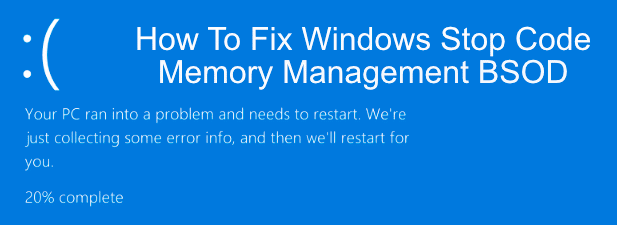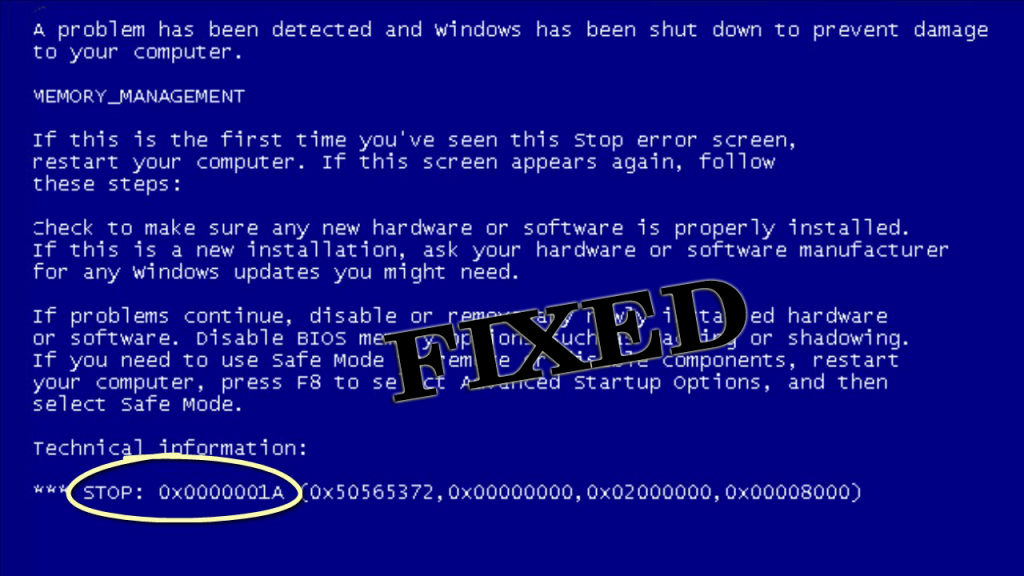
- Window blue screen memory management drivers#
- Window blue screen memory management update#
- Window blue screen memory management driver#
- Window blue screen memory management Patch#
- Window blue screen memory management windows 10#
recently serviced, re pasted, the i5 is liquid cooled where the 17 has a more than adequate CPU fan and temperatures on both machines are well within safe limits a Haskell i7(k) and again at standard clock speeds the same crap happens! Here’s where we get the “ecpert” weighing in… “Check your Graphics card, hardware etc,) The i5 has an AMD Radeon RX 5800 on board and the i7 a GTX750Ti… Lowest common denominator again… guess who? and guess what, I also have a second rig. I have a Coffee Lake i5(K) Gaming rig and even at standard clock speed with 32Gb on Ram and running only 2 programs I get freeze ups, memory messages, address messages or App windows that are whited out and frozen! In particular when trying to play games on steam or transcode videos with handbrake I get crashes, memory adressing messages or restarts. What total Bollocks! The problem comes down to the lowest common denominator as awlays, Microsoft – heres why! Visit the website of the manufacturer and download any updates to get your system working correctly again.

External video cards have more memory than onboard graphics, and they are more prone to overheating.
Window blue screen memory management windows 10#
Windows 10 will be able to tell you what you have in your system, but it’s likely to be onboard Intel graphics or something from Nvidia or AMD.
Window blue screen memory management drivers#
The drivers you need will depend on your graphics card, of course.
Window blue screen memory management driver#
Sometimes, a driver is broken or corrupt but goes undetected. If you already have the latest drivers, try the “uninstall/reinstall” method. If you’re not running the latest version, try installing the newest available. This scenario makes sense, especially since the graphics card has memory too. One of the most common causes of the memory management error in Windows 10 is outdated or broken graphics card drivers.
Window blue screen memory management update#
Step 5: Update Your Graphics Card Drivers Isolating and correcting a software issue or even a corrupted file can take a while, but it’s certainly worth it if you’re not entirely sure you’re experiencing a hardware failure. You can try disabling and re-enabling newer software to see if that fixes the BSOD, or you can reload Windows 10 entirely (although this is a nuclear option). Specific pieces of software often link to memory management errors. Still, if the memory management error is a relatively new phenomenon, you could try undoing some of your recent software installations to see if it fixes the problem. Software problems are a little more challenging to pin down. Note: It is best to perform two or three rounds of scanning since the process doesn’t always detect anything on the first attempt or fixes something else and needs to find more issues. Some users have found that their computers play nicer after a complete scan, even if nothing gets found. SFC Scanner will now run through your system, seeing if it finds any disk errors to fix.


If the problem still occurs, you may need to replace some faulty hardware.
Window blue screen memory management Patch#
If the memory management error ceases, you’ll know it isn’t hardware but rather something in the software, such as a patch in an update or a driver. Essentially, this shuts down any processes the computer doesn’t need. This action allows you to check whether you still receive the BSOD Memory Management error. The first thing you should do is launch Windows 10 in safe mode with only basic drivers. Let’s take a look at what you can do to get this fixed. With Window’s ominous errors, such as this one, it may be challenging to know where to begin.īasic troubleshooting is essential to finding your memory management error. The first step in fixing any computer problem is isolating the issue’s source so you know what to fix.


 0 kommentar(er)
0 kommentar(er)
